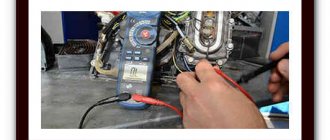One of the undeniable advantages of carob coffee makers and coffee machines is that they prepare delicious and aromatic coffee with exquisite foam, which is called “cream” (in the French manner - with an emphasis on the last syllable). And in these machines you can prepare real cappuccino with delicate milk foam (experienced baristos often call it “foam” - from the English “foam”). However, from time to time you may notice that the cream is not as fluffy and thick as before, and the milk does not froth at all. To prevent the above problems from marring your morning coffee ritual, do not neglect the need to diagnose the device and timely repair it.
The masters of the Service company are not only familiar with the operating principle of coffee machines - they have studied it not only in theory, but also in practice, thanks to which they can quickly and easily put even the most complex device in order.
We work with economy-class household appliances and professional devices, and we always provide a guarantee on the services provided and the parts installed. You can leave a request for a specialist visit, call 8 (495) 745-24-00 or fill out a simple form on our website. The master is ready to go from 8:00 to 23:00 every day, on holidays and weekends, the service area of our employees is Moscow and the Moscow region.
The coffee machine does not make cream: reasons
In fact, there are quite a lot of factors influencing the quality of the cream, and not all of them are related to the operation of the device. In particular, the type of coffee, the method of roasting and grinding it, and the freshness of the beans are directly related to the possibility of obtaining foam.
As for the reasons related to the functional features of your coffee machine, the following can be mentioned:
- Water temperature. Ideally, it should be between 90 and 95 degrees.
- Pressure. If the pump does not provide enough pressure, the cream will not form - most likely, the end result will be coffee that tastes and looks similar to the drink from a regular cheap coffee maker.
- Pressing quality of ground coffee.
- Functional features of the coffee grinder. First of all, this concerns the millstones - they must be sharp. On average, a coffee machine must grind up to 250 kg of beans, after which the millstones must be replaced.
- Grinding It is preferable to use medium grind coffee.
- Design features of the coffee maker. It is highly desirable that it be straight, allowing the ground grains to immediately fall into the horn. This will eliminate the possibility of making stale coffee that is not capable of producing thick foam.
- Horn heating temperature.
- The process of making espresso. Ideally, the machine should extract 40 ml of drink in 30 seconds.
By ensuring that these conditions are met, you can easily enjoy aromatic coffee with thick foam.
The machine does not froth milk
Most people buy coffee machines for their home because they “know how” to prepare an unsurpassed latte or cappuccino, decorated with thick and dense milk foam. When the device breaks down and stops producing foam, most people tend to immediately call a specialist, which can be done by waiting.

Coffee machine froths milk
The main reasons why the coffee machine stopped making foam:
- The milk frother is too dirty. A special device, a cappuccino maker, froths the milk into foam in the machine. If it is not cleaned after each coffee preparation, it will soon fail due to clogged air channels.
Important! If the cappuccino maker is dirty, this will affect the taste of the drinks.
- Incorrect milk temperature. It is necessary to feed milk into the coffee machine after it has been taken from the refrigerator.
- Milk is too lean. To use in automatic coffee makers, you need to buy the “fattest” milk; lean froth does not work.
Important! Dry or baked milk cannot be served into the coffee machine.
- The steam function is not turned off. This applies to appliances that do not have automatic milk frothing.
If none of the above reasons were found, and the problem that the coffee machine stopped frothing milk remains, you need to check the panarello. The part could fail due to scale, blockage in the steam supply hole, or failure of the thermostat.
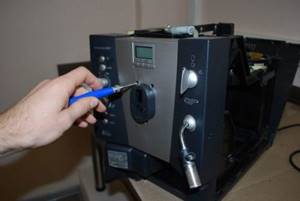
Coffee machine repair
Coffee machine breakdowns affecting the quality of the cream
Based on the above reasons, there are several of the most common breakdowns that affect the quality of the cream:
- Failure of the heating element, as a result of which the water temperature rises above 95 degrees, or, on the contrary, does not reach 90 degrees. Possible solutions are descaling the machine or completely replacing the heating element or boiler.
- Accumulation of large amounts of limescale and other contaminants on the internal components of the device. This directly affects both the temperature of the water in the boiler and the pressure with which water and steam are supplied to the brewing mechanism. Decalcifying and cleaning the device from oils may help solve the problem.
- The coffee grinder is broken, which may result in the beans being ground too coarsely.
- A decrease in pressure in the system caused by a malfunction of the pump or pump.

You can decalcify the coffee machine without resorting to the services of a specialist, but if after this the foam is still weak, immediately call a technician from the service center - he will conduct a comprehensive diagnosis and perform maintenance and, if necessary, repair of your device.
Why did the coffee machine stop frothing milk?
Don't panic if your coffee maker suddenly stops frothing milk. The reason may not be a technical breakdown of the device; there are also more trivial reasons for the lack of the desired foam:
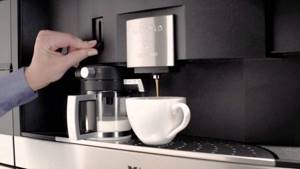
- To prepare a latte or cappuccino, milk must be poured into a panarello (or otherwise known as a cappuccino maker). You need to disassemble the device in order to wash this element after each preparation of your favorite drink. A dirty nozzle or clogged air channels cause a lack of foam and a deterioration in the taste of the finished coffee.
- Milk can be frothed in a coffee machine only if used cold. Its temperature should not exceed 4 degrees, that is, before adding milk to the coffee maker, it must be stored in the refrigerator.
- Milk with a low fat content does not froth well or does not froth at all. To prepare a delicious cappuccino, you must use pasteurized milk with a fat content of 3.5%. Powdered milk is generally not suitable for making coffee.
- If your coffee machine is not equipped with an automatic milk frothing system, then the user must be able to independently turn on the steam function.
However, not everything depends on timely cleaning of the cappuccino maker, using the right milk and the ability to turn on steam. Malfunctions in the operation of the panarello are also possible:
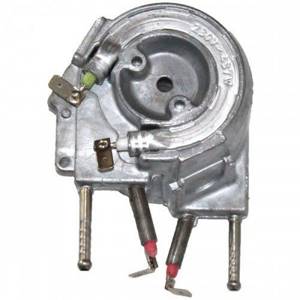
- failure of the steam unit;
- scale formation directly in the steam supply system;
- formation of a blockage in the steam supply hole, which cannot be removed with your own hands;
- a malfunction occurs with the temperature sensor.
Solving these problems on your own can lead to complete failure of the equipment, so it is recommended to contact professional technicians to troubleshoot the cappuccino machine.
The coffee machine does not froth milk: reasons and solutions
First of all, let's rule out the possibility that you are not doing everything according to the instructions - let's assume that all the manufacturer's recommendations have been taken into account. If in this case your coffee machine does not make foam well, pay attention to the presence of steam - after all, it is with its help that the cappuccino machine turns milk into airy foam.
So, if the coffee machine does not produce steam when you turn on the steam mode, call the service center without hesitation. There are several reasons why there is no steam:
- Failure of the steam unit or damage to its power elements.
- Thermal sensor failure.
- The nozzle is clogged due to a large accumulation of limescale or dried milk residues in the steam supply system.
It is best to entrust the troubleshooting of the above problems to a specialist, without attempting to carry out the repair yourself. First, you may need special diagnostic tools and equipment. Secondly, unqualified intervention in the operation of the device can lead to irreparable consequences.
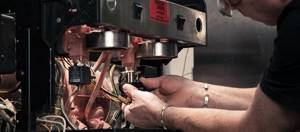
If, after checking, it is determined that steam is still supplied, but the thick “foam” in milk stubbornly does not want to whip, pay attention to the following nuances:
- Carefully check the cleanliness of the cappuccino maker nozzle. It has a tiny hole for steam supply, so even the slightest blockage makes frothing milk much more difficult. It is recommended to use a thin toothpick to clean the nozzle. By the way, it is necessary to thoroughly wash the nozzle after each use - this way you will not only avoid blockages, but also eliminate the possibility of creating favorable conditions for the proliferation of pathogenic microorganisms.
- Check the connection between the milk tank and the machine - perhaps the milk is not “captured”, and therefore the foam cannot be whipped.
- If everything is in order with the nozzle, then another reason may be the accumulation of scale, which can be removed using special means or simple citric acid.
- Look at the fat content of the milk. Ideally, it should be no less than 2.5 and no more than 3.5%, and its temperature should not be higher than 4 degrees. It is also not recommended to use powdered milk - only pasteurized milk.
Of course, to obtain “foam” you need, among other things, to have some experience working with a cappuccino maker and follow the instructions for your coffee machine.
Why doesn't the cappuccino maker work or froth the milk?
Let us repeat that first of all, you need to pay attention to the milk you use. Its fat content should be from 2.5% and not exceed 3.5%. It is important that the milk is pasteurized and not powdered.
Next, you need to make sure there is steam supply. Owners of devices with a panarello nozzle just need to start the steam function. If there is no steam, then you cannot do without the help of an experienced technician, as this may indicate:
- failure of the vapor block
- temperature sensor malfunction
- steam vent clogged
- scale in the steam supply system
If there is steam supply, but the milk does not froth, then you need to remove the nozzle and inspect the hole on it. If the hole is clogged, it must be cleaned, but this must be done very carefully. We do not recommend using very sharp objects. Alternatively, you can use a toothpick. If the hole is damaged, the cappuccino maker may permanently fail.
If the coffee machine produces insufficient steam, this signals the need to decalcify. If the procedure does not give the desired effect, the technician will diagnose the operation of the pump, sensors and other components of the coffee machine.
If milk does not suck in, then you need to check the connection between the hopper and the machine or inspect the frother; perhaps the reason is its malfunction.
Summarize. The main reasons why the cappuccino maker does not work:
- Milk does not flow into the coffee machine due to a clogged supply system
- Temperature sensor/steam supply unit faulty
- Steam vent clogged
- Milk is not suitable for making cappuccino in a coffee machine
- Air channels clogged
- Dispenser installed incorrectly
We have noted the main reasons, but an experienced specialist should diagnose the breakdown. Service technicians are highly qualified and have many years of experience, so they can easily diagnose and fix the problem in the shortest possible time. We provide a company guarantee for all services.
Coffee machine repair in Moscow and Moscow region
Initial setup and further maintenance of household appliances performed by a professional is the key to its long-term uninterrupted operation. Service specialists are constantly improving the level of their qualifications and are able to troubleshoot even the most complex devices in the shortest possible time. We have all the necessary original spare parts in stock, our technicians have the latest diagnostic and repair equipment. In order to call a specialist to your home, just call us by phone 8 (495) 745-24-00.
What to do if the coffee machine does not froth milk?
If the cappuccino doesn't work out, first re-read the instructions. You may have set up the machine incorrectly, did not add the required amount of milk, or made another mistake. Try repeating all the steps again.
Have you made cappuccino before and it worked, but now it doesn’t work? Check everything carefully:
- steam supply;
- pump;
- the quality of the milk (perhaps this is why foam is not produced);
- condition of the nozzle.
The nozzle must be cleaned regularly (only in this case the milk will be served and frothed), and the system itself must be decalcified. Due to scale, the steam may be too weak. To remove deposits, you will need special tablets that come with your Siemens coffee machine.
What repairs will be needed if the coffee machine does not froth milk?
The type and budget of repairs depends on the nature of the breakdown. If neither cleaning nor decalcification helps, and you use only high-quality milk, the reason is a malfunction. A specialist will find her. It may be necessary to replace sensors, nozzle elements or automatic (semi-automatic) milk frothing systems, pumps. Sometimes repairing one of the elements or professional cleaning of the system is enough.
Clean your Siemens coffee machine regularly, use high-quality water, and problems with foam will be avoided.
